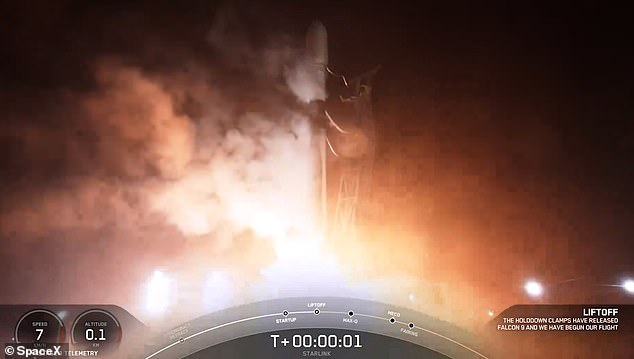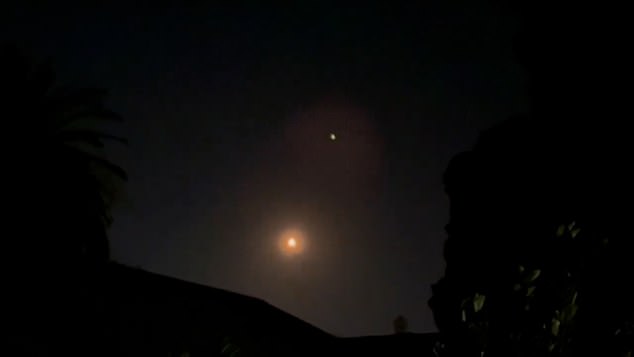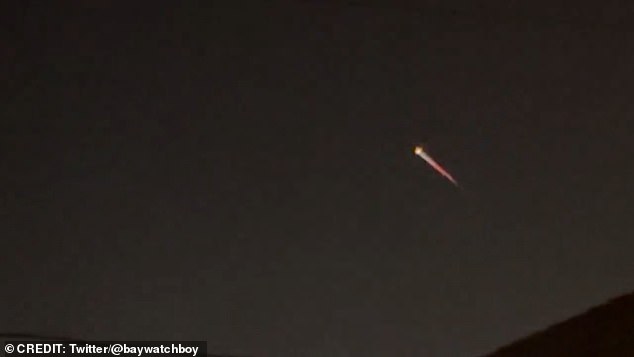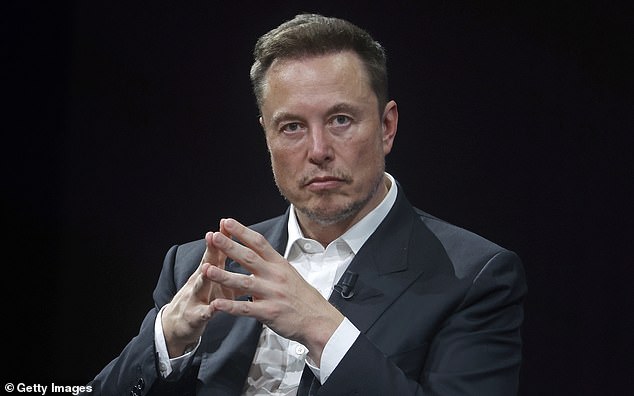Onlooker captures incredible moment Elon Musk’s SpaceX rockets are fired into space as tech mogul launches another batch of Starlink satellites from Cape Canaveral
This is the incredible moment someone captured a rocket flying into space from Elon Musk’s SpaceX launch.
Spectator footage in Santa Barbara, California shows a bright orange light rising into the sky after the launch of the Falcon 9 ship carrying 22 Starlink satellites into low Earth orbit.
Another eyewitness posted a similar video on X, formally known as Twitter, of the rocket soaring high into the night sky with the caption: “That was pretty cool.”
The launch took place at Vandenberg Space Force Base in California at 12:59 a.m. local time, with a live webcast of the mission on the company’s social media pages.
SpaceX confirmed the successful deployment of the 22 satellites just after 2 a.m. PT, which the company says will help them provide high-speed, low-latency connectivity worldwide.
Spectator footage in Santa Barbara, California shows a bright orange light rising into the sky after the Falcon 9 launch of 22 Starlink satellites into low Earth orbit

The launch took place at Vandenberg Space Force Base in California at 12:59 a.m. local time, with a live webcast of the mission on the company’s social media pages.

SpaceX confirmed the successful deployment of the 22 satellites just after 2 a.m. PT, which the company says will help them provide high-speed, low-latency connectivity around the world

Another eyewitness posted a similar video on X, formally known as Twitter, of the rocket taking off high into the night sky with the caption: ‘That was pretty cool’
After separation from the multi-stage rocket, the first stage of the spacecraft landed on the drone ship Of Course I Still Love You, which is stationed in the Pacific Ocean.
This was the 18th flight for the first stage booster supporting this mission, which previously launched Crew-1, Crew-2, SXM-8, CRS-23, IXPE, Transporter-4, Transporter-5, Globalstar FM15, ISI EROS C- 3, Korea 425 and seven Starlink missions.
The company’s latest launch has a host of social media users excited, with one writing: ‘SpaceX continues to make history while we all sleep!’, another saying: ‘Always a joy to watch’.
SpaceX was founded in 2002 by Elon Musk with the aim of reducing space transportation costs and colonizing Mars.
The company currently operates the Falcon 9 and Falcon Heavy rockets along with the Dragon and Starship spacecraft.
Starlink is Musk’s precious satellite internet system that prides itself on offering an experience that requires minimal support and most elements, including setting up a dish, are managed through their app.
However, rural homeowners who switched to the system have criticized the company’s customer service.
While some villagers have praised Starlink as ‘life-changing’, other users who pay £449 plus £75 a month are angry at the lack of help if they have connection problems.
The hands-off approach may be preferable when all goes well, but it irritates users who have flocked to social media and Trustpilot to share their complaints.
It has been reported that villagers have been forced to endure endless roadworks and temporary traffic lights as trenches are dug and telegraph poles erected in preparation for a major digital rollout in Stocksfield, Northumberland.
Slow broadband speeds are being felt across the country. Experts tell MailOnline that there is ‘a lot of red tape’ around connecting these rural areas.

Scientists worry about the potentially harmful effects of Musk’s ‘space junk’ and what it could do to Earth’s orbit
Fed up with waiting for faster broadband, some have switched to Musk’s £449 satellite internet system, which helps connect the most isolated parts of the British countryside using broadband broadcast from space.
Alex Tofts, broadband expert at Broadband Genie, told MailOnline: ‘I wouldn’t be surprised to see more people go this route, just because of the wider issue of the rural broadband landscape, where households and people are clearly being left behind.’
Starlink has been praised for providing internet in war-torn Ukraine, but astronomers fear the devices will soon obscure our view of the cosmos – with around 9,000 stars visible from our planet.
New research has shown that low-frequency radio waves – like those produced by Musk’s machines – are leaking into the air, making it difficult for scientists to make astronomical observations.
Scientists are also concerned that Musk’s ‘space junk’ could cause an extreme collision. The ‘Kessler syndrome’ – proposed by NASA scientist Donald Kessler in 1978 – said that if there is too much space junk in Earth’s orbit, the objects could collide and form MORE space junk. This would cause the Earth’s orbit to become unstable.
